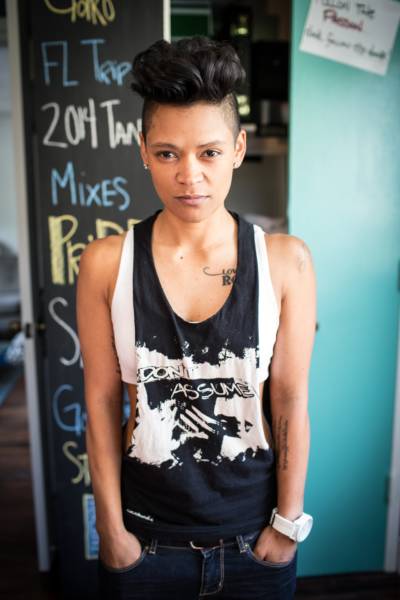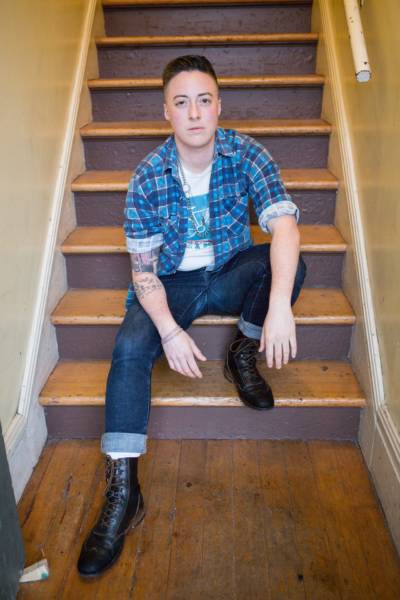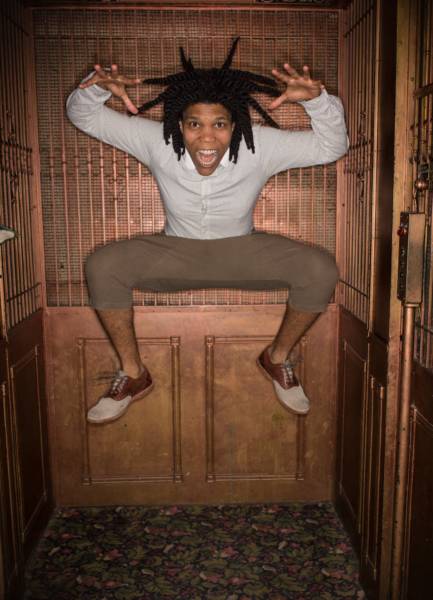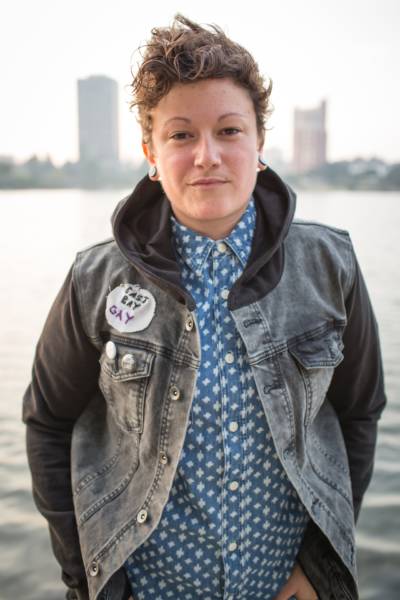Oakland photographer Meg Allen didn’t set out with a particular goal in mind when she started BUTCH, a collection of San Francisco-based portraits celebrating the Bay Area’s queer community. In fact, during the first days of the project, her friends were simply posing to help Allen, a self-taught artist, work on her portraiture skills. But in the process of taking these pictures, something fantastic emerged.
“I realized how awesome it would be to fill a wall with butch portraits; a wall led to two walls, to a room and now a book,” says Allen, who grew up in San Francisco. “I felt so proud to see queers and women who looked like me en masse; I decided that should be my first body of work.”

Allen now has 100 portraits in the series BUTCH, which will be on display at Glama-Rama Salon in San Francisco through July 3. An opening reception is scheduled for Saturday, May 21 at 7:30pm.
The series captures the diversity and beauty of the Bay Area’s self-identified butch community through Allen’s skill behind the lens. The portraits feel intimate, offering glimpses into each personality captured on film. Allen hopes to publish the collection once she’s reached 123 portraits; the same number of photographs Annie Leibovitz — a huge influence on Allen’s work — printed in her 1999 book, Women.
Once cherished as a hotbed of counter culture, San Francisco has changed dramatically in the wake of the tech boom. BUTCH celebrates an aspect of the city that has shifted from a melting pot at the fringes of society to a community many feel is being watered down and diluted.
“Queers and artists and marginalized social groups used to proliferate the city population here and the influx of the tech industry has sort of taken over,” says Allen, who watched many of the subjects in her work move away in recent years. “This city is notorious for her fickle population preference tendencies, so it is what it is, but I definitely miss the San Francisco I came of age in. I miss the dykes and the drag queens and the leather daddies and that the Mission used to be a Latino neighborhood.”

Allen definitely feels the complexity of a stronger acceptance of queer culture across the country (she uses both terms “queer” and “women,” pointing out that not everyone who identifies as butch identifies as a woman). On the one hand, at least in major cities, there is a stronger sense of safety in queer communities. On the other hand, Allen comments on the closing of the Lexington Club as one example of San Francisco’s many changes.
“It’s such a bummer that lesbians don’t have that spot to congregate anymore, and at the same time it’s nice to be fully embraced by a straight world that doesn’t see sexuality as a stigma anymore. It’s a weird thing to know both,” she says. “Queers in my age group have gotten to see and experience gay acceptance and yet we also have a visceral memory of the hate and the threat of violence.”
Allen says that because of the changing climate of queer acceptance, she was able to photograph many friends who may have been hesitant to participate in BUTCH 20 years ago. Still, there remains a lack of representation of butch culture in mainstream media.

“I think even less images exist where butches show their naked bodies. Beauty in women has never favored masculinity, so to be masculine as a woman was to be less valued in society. I think it still is. Look at all the female athletes,” she says. “TV and media hardly glamorize their strength; it’s all they can do to get them into pink, get their hair fixed and makeup placed before they honor them as athletes. It’s like this unsaid thing that women can be athletes as long as they still look like beautiful women, and not masculine lesbians.”
BUTCH is a timely and important project for a number of reasons. Gender conformity and non-binary gender identity are hot button issues in America — all one needs do is look at the manic transphobia in regards to proposed public restroom laws in places like North Carolina and the conversations taking place around what it does and doesn’t mean to identify or present as a specific gender; and what kind of societal expectations come along with those identities.
“I think the topic is touching on a nerve that no one wants to face and that is of what gender means in this country,” says Allen. “What does it mean to be a man who wants to live as a woman, and vice versa? Why are we fearful of this? The answer always seems to be of some fear of sexual perversion.”

BUTCH touches on something deeper than the national political debate around who can and can’t use certain restrooms. Allen’s portraits feel personal. They invite us to examine our own identities, our own standards of beauty, and how we each relate to one another. The collection feels urgent and celebratory and everything in between.
“For those of us who have never had our identity and aesthetic celebrated publicly, there is always a small sense of rejection from society,” says Allen. “What this work does is give the people in the portraits a moment to be seen as regal and beautiful as they are, as I see them, and gives anyone who lives outside of queer culture the chance to stare and really take in the gender ambiguity in the privacy of their own brain. I think most of the straight world doesn’t realize how fearful they are, for reasons unclear to them, of gender disconformity.”
BUTCH is on view at Glama-Rama Salon in San Francisco through July 3. An opening reception is scheduled for Saturday, May 21 at 7:30pm. For more information visit glamarama.com.